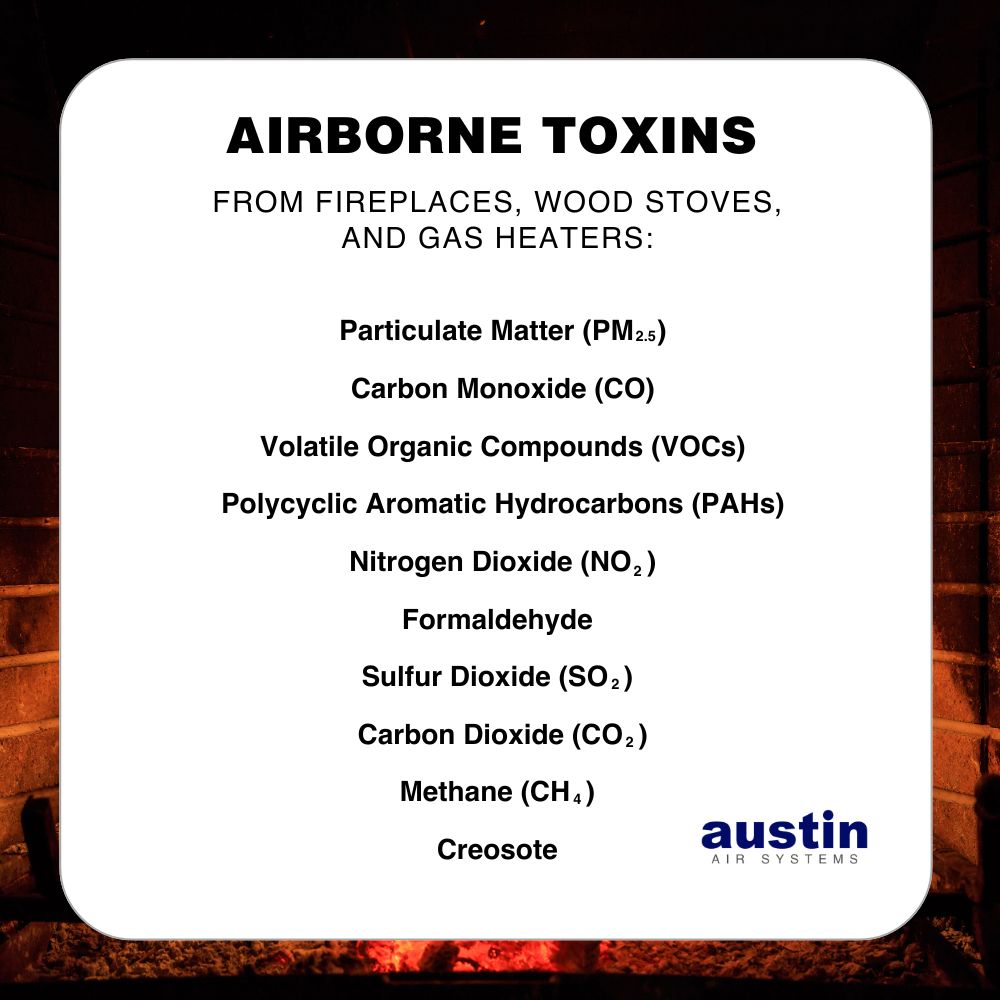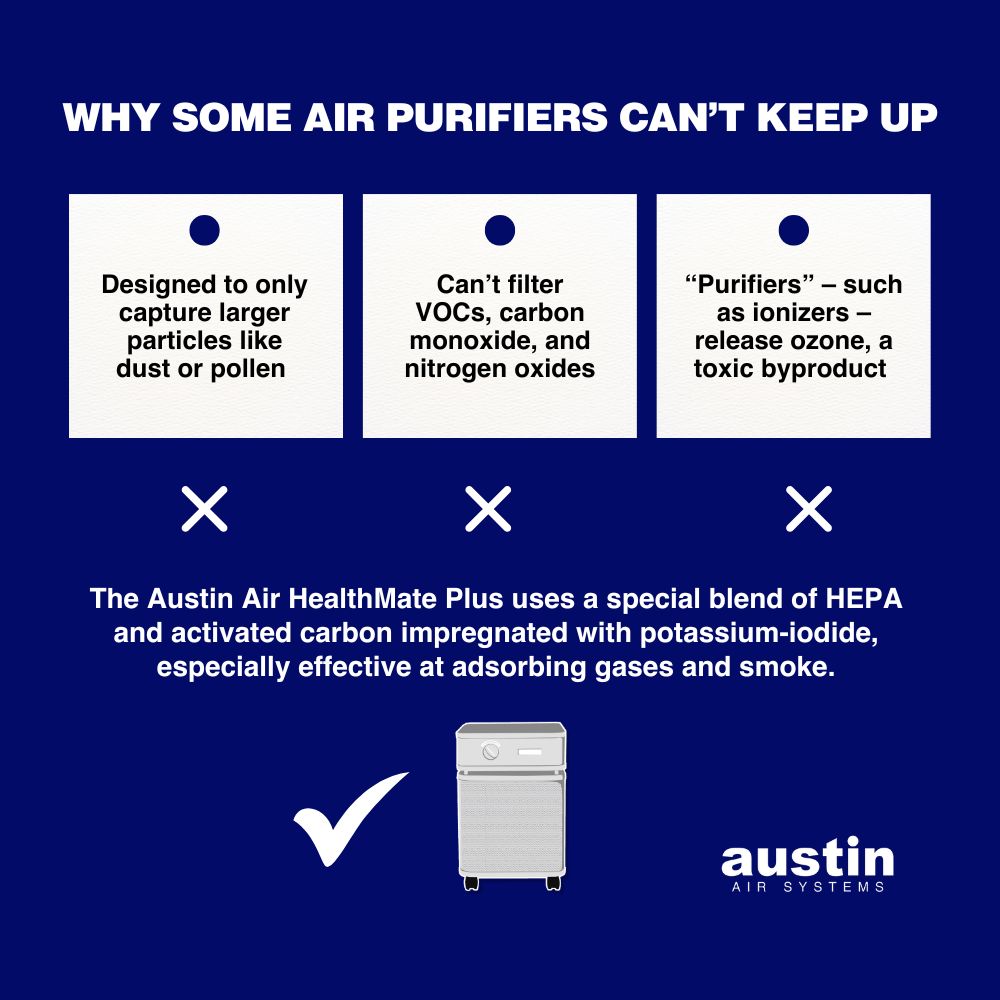As the first frost blankets much of the U.S. this week, it’s natural to want to cozy up indoors. Few things feel more comforting than curling up in front of a warm fireplace or turning on a space heater. But while these heat sources bring comfort, they can also introduce serious air quality concerns.
In this post, we’ll explore the various heating options – fireplaces, wood stoves, space heaters, and more – and the pollutants each releases into the air. We’ll also share how some air purifiers fall short of filtering these contaminants and explain why investing in an Austin Air Purifier can help protect your home and family. Plus, we’ll provide some essential safety tips for using these heat sources.
Understanding Heat Sources and Their Pollutants
Wood-Burning Fireplaces
Wood-burning fireplaces have a classic charm, but they’re among the worst offenders when it comes to air pollutants. Burning wood produces fine particulate matter (PM2.5), carbon monoxide (CO), and volatile organic compounds (VOCs), which can easily infiltrate your home’s air. These tiny particles can travel deep into your lungs, leading to respiratory issues, especially for those with asthma or other sensitivities.
In addition to respiratory health risks, wood smoke contains chemicals like benzene and formaldehyde, which are known carcinogens. Even low levels of these toxins can build up over time, making wood-burning fireplaces not just a short-term hazard but also a long-term health concern.
Another concern is creosote buildup in chimneys, a tar-like substance that accumulates as wood burns. Creosote reduces airflow, which can increase the concentration of pollutants inside the home. It also poses a serious fire risk if not properly maintained, as creosote is highly flammable and can lead to chimney fires if allowed to accumulate.
Wood Stoves
Wood stoves are more efficient than open fireplaces, but they still release pollutants, including PM2.5, nitrogen oxides (NOx), and VOCs. Even modern EPA-certified wood stoves, while significantly cleaner, still emit fine particulates that can affect indoor air quality.
The efficiency of wood stoves depends on how well they burn the fuel. Modern stoves can burn wood more completely, leading to less smoke and fewer pollutants, but even small amounts of smoke contain fine particulates that are harmful to the lungs. This means the type of wood you burn matters just as much as the stove itself. Wet or improperly seasoned wood produces more smoke and releases more harmful chemicals, including methane and polycyclic aromatic hydrocarbons (PAHs), which are linked to cancer.
Even proper ventilation systems can’t capture all the pollutants from wood stoves, which means it’s important to ensure your home is well-ventilated whenever the stove is in use.
Gas Fireplaces
Gas fireplaces are a cleaner alternative to wood-burning ones, but they aren’t pollutant-free. They emit nitrogen dioxide (NO2) and carbon monoxide (CO), especially when venting isn’t optimal. While they may not produce as much particulate matter as burning wood, these gases can contribute to poor indoor air quality, leading to health issues like headaches, dizziness, and respiratory irritation.
Nitrogen dioxide in particular can aggravate respiratory conditions like asthma and decrease overall lung function. The risk is greater in homes with poor ventilation, as gas combustion produces invisible but harmful gases that may not be easily detected without proper monitoring.
Unvented gas fireplaces, which are designed to operate without an external chimney, can be particularly dangerous. These models can release higher levels of NO2 and CO directly into your living space, increasing the likelihood of indoor air quality issues. Even vented gas fireplaces can release small amounts of these gases, especially if the venting system is compromised.
Electric Space Heaters
Electric space heaters are among the safest heating options in terms of air quality since they don’t release combustion pollutants. However, they can still circulate dust, pet dander, and other allergens, especially if they have a fan system. This can irritate sensitive respiratory systems if your air isn’t adequately filtered.
Though electric heaters don’t introduce combustion byproducts like carbon monoxide or nitrogen dioxide into the air, they can stir up particles already present in the room. Heaters with fans are particularly prone to distributing allergens, dust, and other airborne irritants that may have settled on surfaces. Additionally, heaters with poor ventilation or malfunctioning components can become hotspots for dust accumulation, potentially causing overheating and triggering burning odors.
For homes with electric heaters, the key air quality concern is maintaining a clean environment, free from dust and allergens that could circulate through the heater’s airflow.
Why Some Air Purifiers Can’t Keep Up
Not all air purifiers are effective at handling pollutants from heat sources. Many low-quality or basic air purifiers are designed to capture larger particles like dust or pollen but fail to filter out the fine particulate matter and gases released by wood and gas burning. VOCs, carbon monoxide, and nitrogen oxides require advanced filtration technologies, like activated carbon, which not all purifiers have.
Worse, there are air “purifiers” – such as ionizers – which release ozone, a toxic byproduct that actually lowers the air quality, instead of improving it.
This is where Austin Air purifiers stand out. Equipped with HEPA filters and activated carbon, Austin Air purifiers can capture particles as small as 0.1 microns, including fine particulates. The Austin Air HealthMate Plus is your best bet for clean air in the home for a variety of different heat sources. Using a special blend of HEPA and activated carbon impregnated with potassium-iodide, the HealthMate Plus is especially effective at adsorbing gases and smoke. This is something that can bring peace of mind during wildfire season too.
Tips for Protecting Your Air and Staying Safe This Winter
Beyond investing in a high-quality air purifier like the Austin Air HealthMate Plus, here are additional steps you can take to ensure safe and healthy air when using fireplaces, stoves, or heaters this autumn and winter:
- Ventilation is key: Always ensure that your fireplace or stove is properly vented to the outside, and use an exhaust fan when using gas heaters.
- Maintain your chimney: Regularly clean and inspect your chimney to prevent creosote buildup and ensure proper airflow.
- Use “seasoned” wood: When using wood stoves or fireplaces, burn only dry, seasoned wood. Wet wood produces more smoke and releases more harmful pollutants. Never use chemical treated wood.
- Install carbon monoxide detectors: Make sure your home is equipped with working CO detectors, especially near bedrooms.
- Keep a fire extinguisher handy: Especially important when using wood-burning fireplaces or stoves.
- Consider electric options: If air quality is a top concern due to respiratory issues, electric space heaters are a safer option as they don’t release combustion pollutants.
Staying warm doesn’t have to come at the expense of your indoor air quality. Understanding the risks associated with different heating methods and choosing the right air purifier can help you enjoy a cozy home without compromising your health. With an Austin Air purifier, you can breathe easy knowing your air is clean, safe, and pollutant-free—even during those long winter nights.



